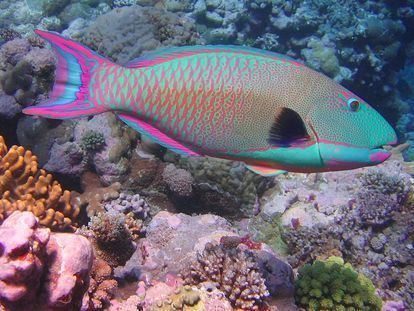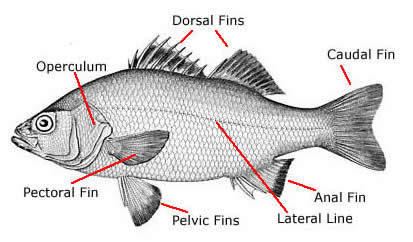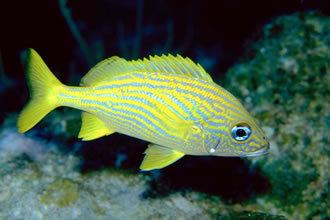Higher classification Chordate | Scientific name Osteichthyes Rank Superclass | |
 | ||
Lower classifications Actinopterygii, Cichlid, Catfish, Cyprinidae, Lungfish | ||
Osteichthyes /ˌɒSTiːˈɪKθi.iːz/, popularly referred to as the bony fish, is a diverse taxonomic group of fish that have skeletons primarily composed of bone tissue, as opposed to cartilage. The vast majority of fish are members of Osteichthyes, which is an extremely diverse and abundant group consisting of 45 orders, and over 435 families and 28,000 species. It is the largest class of vertebrates in existence today. The group Osteichthyes is divided into the ray-finned fish (Actinopterygii) and lobe-finned fish (Sarcopterygii). The oldest known fossils of bony fish are about 420 million years ago, which are also transitional fossils, showing a tooth pattern that is in between the tooth rows of sharks and bony fishes.
Contents

Osteichthyes can be compared to Euteleostomi. In paleontology, the terms are synonymous. In ichthyology, the difference is that Euteleostomi presents a cladistic view which includes the terrestrial tetrapods that evolved from lobe-finned fish, whereas on a traditional view, Osteichthyes includes only fishes and is therefore paraphyletic. However, recently published phylogenetic trees treat the Osteichthyes as a clade.

Characteristics

Bony fish are characterized by a relatively stable pattern of cranial bones, rooted, medial insertion of mandibular muscle in the lower jaw. The head and pectoral girdles are covered with large dermal bones. The eyeball is supported by a sclerotic ring of four small bones, but this characteristic has been lost or modified in many modern species. The labyrinth in the inner ear contains large otoliths. The braincase, or neurocranium, is frequently divided into anterior and posterior sections divided by a fissure.

Early bony fish had simple lungs (a pouch on either side of the esophagus) which helped them breathe in low-oxygen water. In many bony fish these have evolved into swim bladders, which help the body create a neutral balance between sinking and floating. (The lungs of amphibians, reptiles, birds, and mammals were inherited from their bony fish ancestors.) They do not have fin spines, but instead support the fin with lepidotrichia (bone fin rays). They also have an operculum, which helps them breathe without having to swim.

Bony fish have no placoid scales. Mucus glands coat the body. Most have smooth and overlapping ganoid, cycloid or ctenoid scales.
Classification
Traditionally, Osteichthyes is considered a class, recognised on having a swim bladder, only three pairs of gill arches, hidden behind a bony operculum and a predominately bony skeleton. Under this classification systems, the Osteichthyes are paraphyletic with regard to land vertebrates as the common ancestor of all Osteichthyes includes tetrapods amongst its descendants. The largest subclass, the Actinopterygii (ray-finned fish) are monophyletic, but with the inclusion of the smaller sub-class Sarcopterygii, Osteichthyes is paraphyletic.
This has led to an alternative classification, splitting the Osteichthyes into two full classes. Paradoxically, Sarcopterygii is under this scheme monophyletic, as it includes the tetrapods, making it a synonym of the clade Euteleostomi. Most bony fish belong to the ray-finned fish (Actinopterygii).
Phylogeny
The phylogeny of living bony fishes is shown in the cladogram.
Biology
All bony fish possess gills. For the majority this is their sole or main means of respiration. lungfish and other osteichthyan species are capable of respiration through lungs or vascularized swim bladders. Other species can respire through their skin, intestines, and/or Stomach.
Osteichthyes are primitively ectothermic (cold blooded), meaning that their body temperature is dependent on that of the water. But some of the larger marine osteichthyids, such as the opah, swordfish and tuna have independently evolved various levels of endothermy. Bony fish can be any type of heterotroph: numerous species of omnivore, carnivore, herbivore, filter-feeder or detritivore are documented.
Some bony fish are hermaphrodites, and a number of species exhibit parthenogenesis. Fertilization is usually external, but can be internal. Development is usually oviparous (egg-laying) but can be ovoviviparous, or viviparous. Although there is usually no parental care after birth, before birth parents may scatter, hide, guard or brood Eggs, with sea horses being notable in that the males undergo a form of "pregnancy", brooding eggs deposited in a ventral pouch by a female.
Examples
The Ocean sunfish is the heaviest bony fish in the world, while the longest is the king of herrings, a type of oarfish. Specimens of ocean sunfish have been observed up to 3.3 metres (11 ft) in length and weighing up to 2,303 kilograms (5,077 lb). Other very large bony fish include the Atlantic blue marlin, some specimens of which have been recorded as in excess of 820 kilograms (1,810 lb), the black marlin, some sturgeon species, and the giant and goliath grouper, which both can exceed 300 kilograms (660 lb) in weight. In contrast, the dwarf pygmy goby measures a minute 15 millimetres (0.59 in).
Arapaima gigas is the largest species of freshwater bony fish. The largest bony fish ever was Leedsichthys, which dwarfed the Beluga sturgeon, ocean sunfish, giant grouper, and all the other giant bony fishes alive today.
Comparison with cartilaginous fishes
Cartilaginous fishes can be further divided into sharks, rays and chimaeras. In the table below, the comparison is made between sharks and bony fishes. For the further differences with rays, see sharks versus rays.
